Discussion on Anthropocene: Population Growth and Environmental Impact
VerifiedAdded on 2022/08/18
|5
|1512
|10
Essay
AI Summary
This essay examines the concept of the Anthropocene, a proposed new geological epoch characterized by significant human impact on the Earth. It begins by defining the Anthropocene and its implications, highlighting the role of population growth in driving environmental changes. The essay discusses the sixth mass extinction, the impact of fossil fuel usage, agriculture, and industry on climate change. It emphasizes the need for sustainable practices, including reducing consumption, promoting planet-based diets, and considering smaller families. The essay also touches on the importance of empowering women, ensuring access to family planning, and challenging social norms that encourage large families to mitigate the negative effects of the Anthropocene. Finally, it underscores the need for open discussions and transparency regarding the impacts of human activities on the planet.
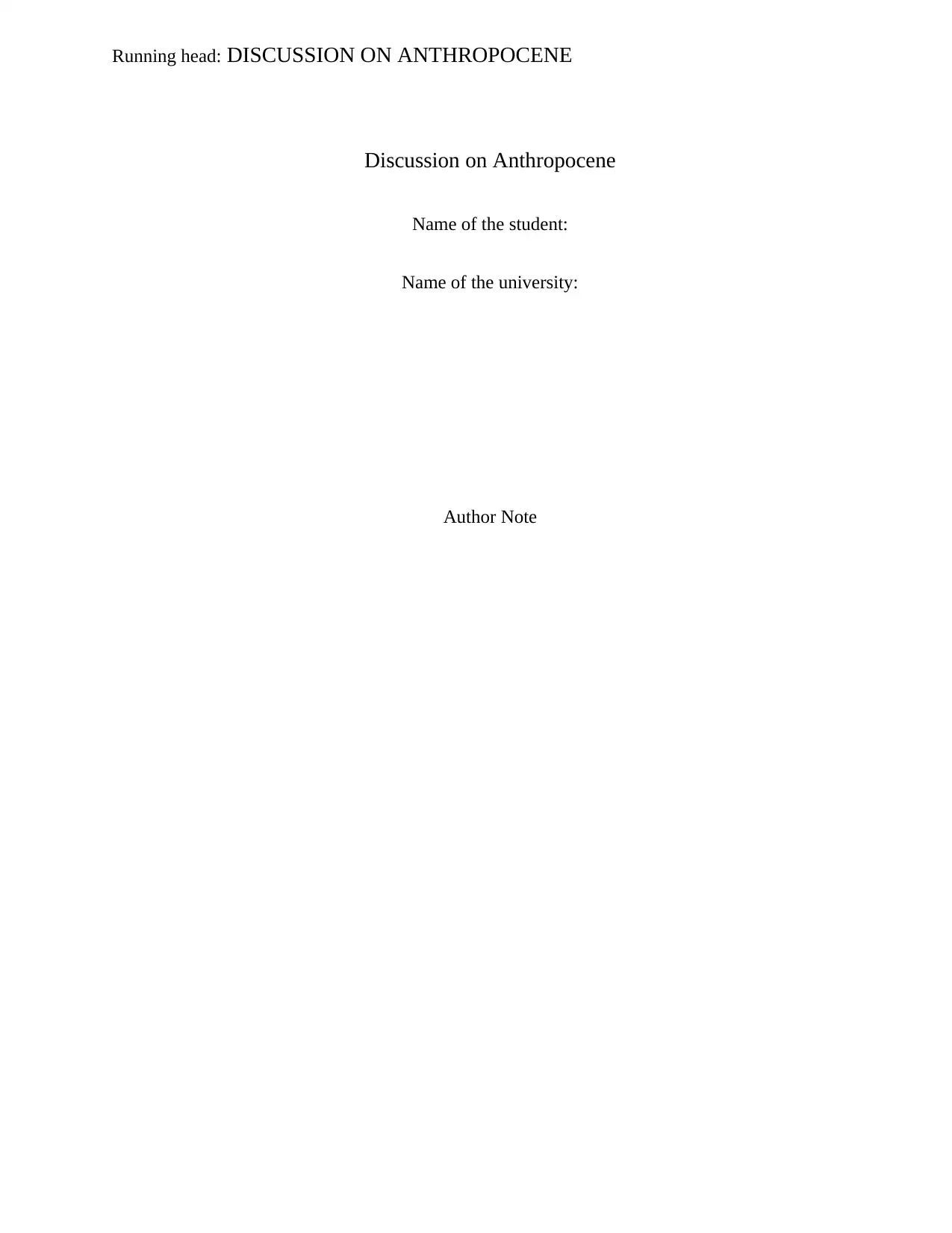
Running head: DISCUSSION ON ANTHROPOCENE
Discussion on Anthropocene
Name of the student:
Name of the university:
Author Note
Discussion on Anthropocene
Name of the student:
Name of the university:
Author Note
Paraphrase This Document
Need a fresh take? Get an instant paraphrase of this document with our AI Paraphraser
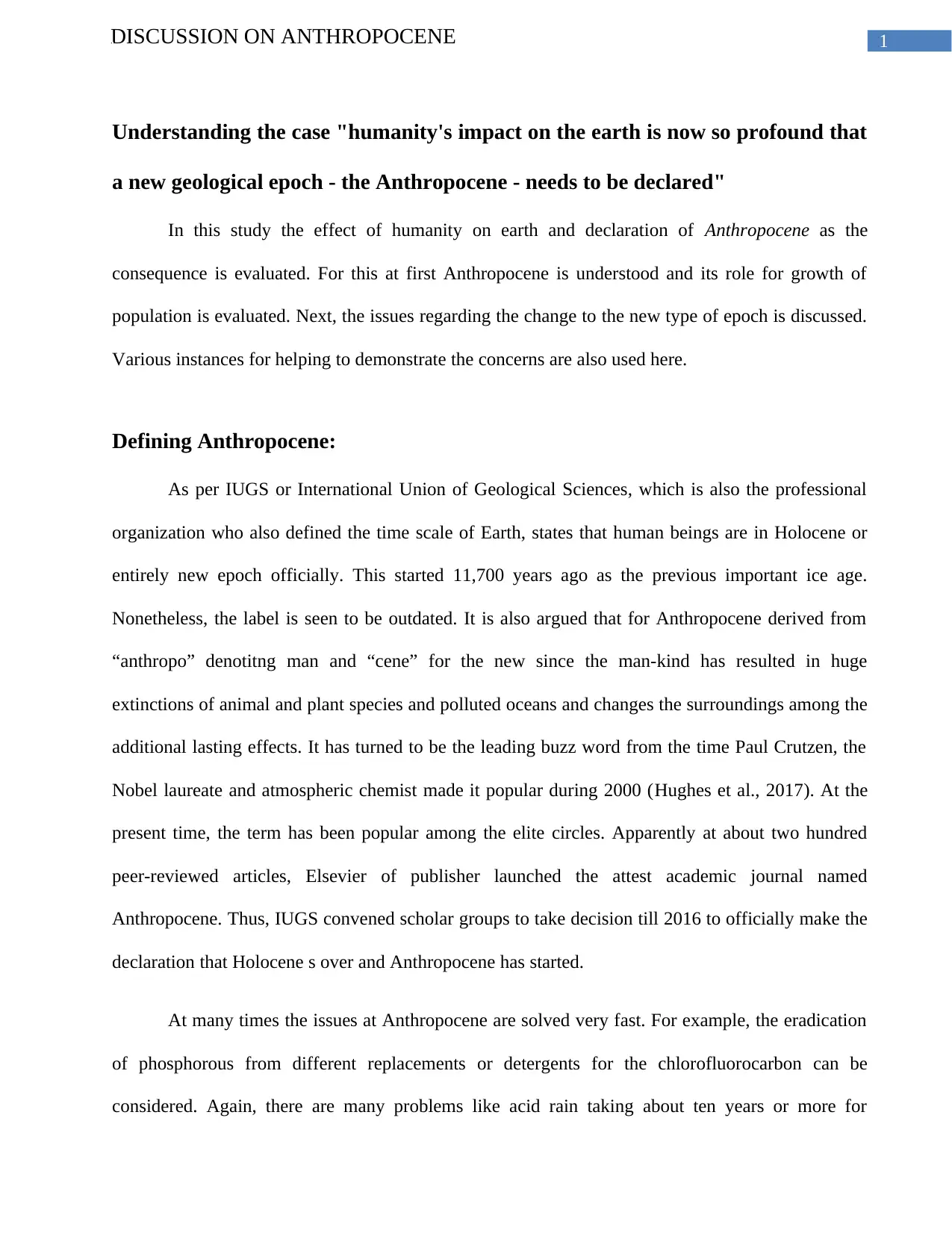
1DISCUSSION ON ANTHROPOCENE
Understanding the case "humanity's impact on the earth is now so profound that
a new geological epoch - the Anthropocene - needs to be declared"
In this study the effect of humanity on earth and declaration of Anthropocene as the
consequence is evaluated. For this at first Anthropocene is understood and its role for growth of
population is evaluated. Next, the issues regarding the change to the new type of epoch is discussed.
Various instances for helping to demonstrate the concerns are also used here.
Defining Anthropocene:
As per IUGS or International Union of Geological Sciences, which is also the professional
organization who also defined the time scale of Earth, states that human beings are in Holocene or
entirely new epoch officially. This started 11,700 years ago as the previous important ice age.
Nonetheless, the label is seen to be outdated. It is also argued that for Anthropocene derived from
“anthropo” denotitng man and “cene” for the new since the man-kind has resulted in huge
extinctions of animal and plant species and polluted oceans and changes the surroundings among the
additional lasting effects. It has turned to be the leading buzz word from the time Paul Crutzen, the
Nobel laureate and atmospheric chemist made it popular during 2000 (Hughes et al., 2017). At the
present time, the term has been popular among the elite circles. Apparently at about two hundred
peer-reviewed articles, Elsevier of publisher launched the attest academic journal named
Anthropocene. Thus, IUGS convened scholar groups to take decision till 2016 to officially make the
declaration that Holocene s over and Anthropocene has started.
At many times the issues at Anthropocene are solved very fast. For example, the eradication
of phosphorous from different replacements or detergents for the chlorofluorocarbon can be
considered. Again, there are many problems like acid rain taking about ten years or more for
Understanding the case "humanity's impact on the earth is now so profound that
a new geological epoch - the Anthropocene - needs to be declared"
In this study the effect of humanity on earth and declaration of Anthropocene as the
consequence is evaluated. For this at first Anthropocene is understood and its role for growth of
population is evaluated. Next, the issues regarding the change to the new type of epoch is discussed.
Various instances for helping to demonstrate the concerns are also used here.
Defining Anthropocene:
As per IUGS or International Union of Geological Sciences, which is also the professional
organization who also defined the time scale of Earth, states that human beings are in Holocene or
entirely new epoch officially. This started 11,700 years ago as the previous important ice age.
Nonetheless, the label is seen to be outdated. It is also argued that for Anthropocene derived from
“anthropo” denotitng man and “cene” for the new since the man-kind has resulted in huge
extinctions of animal and plant species and polluted oceans and changes the surroundings among the
additional lasting effects. It has turned to be the leading buzz word from the time Paul Crutzen, the
Nobel laureate and atmospheric chemist made it popular during 2000 (Hughes et al., 2017). At the
present time, the term has been popular among the elite circles. Apparently at about two hundred
peer-reviewed articles, Elsevier of publisher launched the attest academic journal named
Anthropocene. Thus, IUGS convened scholar groups to take decision till 2016 to officially make the
declaration that Holocene s over and Anthropocene has started.
At many times the issues at Anthropocene are solved very fast. For example, the eradication
of phosphorous from different replacements or detergents for the chlorofluorocarbon can be
considered. Again, there are many problems like acid rain taking about ten years or more for
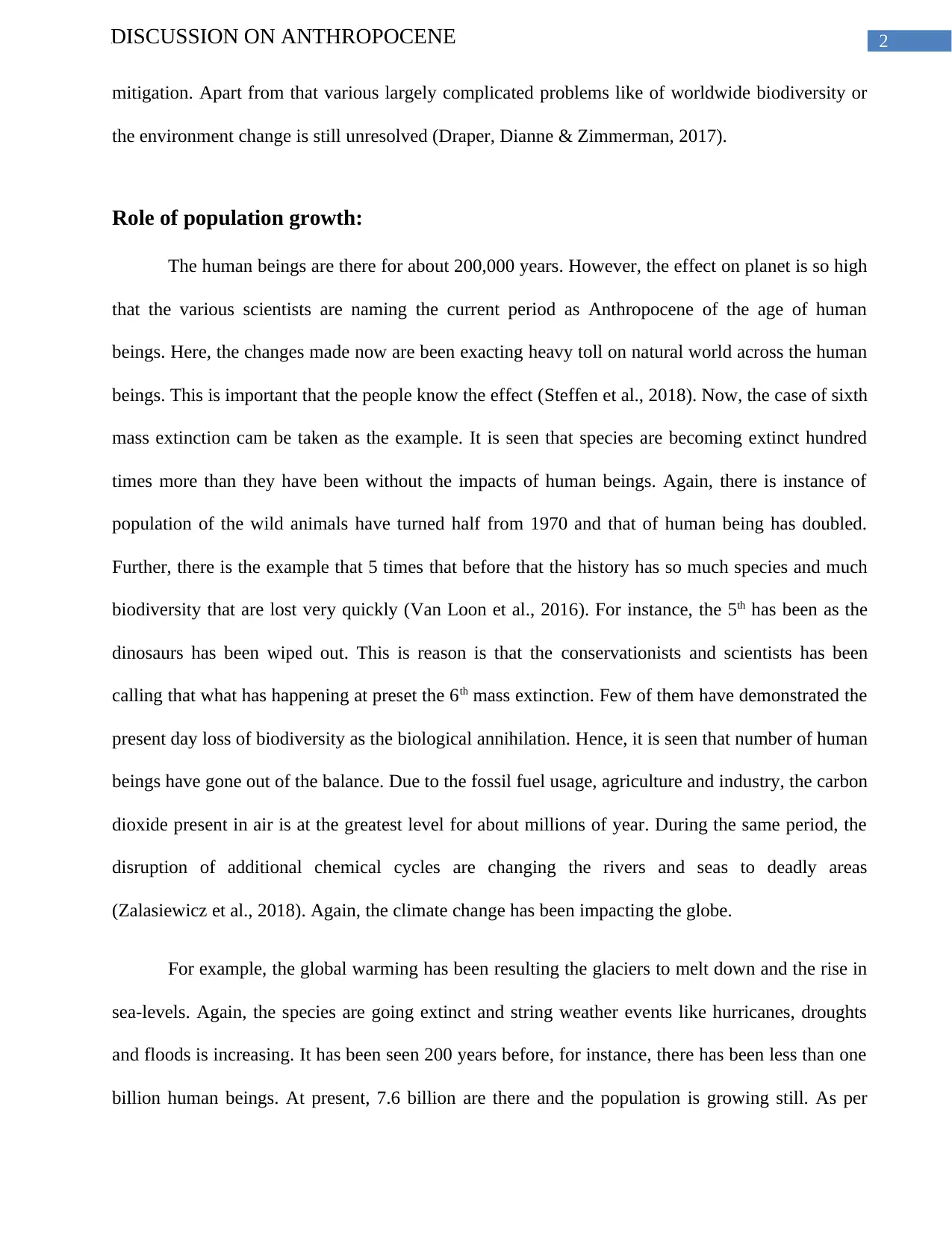
2DISCUSSION ON ANTHROPOCENE
mitigation. Apart from that various largely complicated problems like of worldwide biodiversity or
the environment change is still unresolved (Draper, Dianne & Zimmerman, 2017).
Role of population growth:
The human beings are there for about 200,000 years. However, the effect on planet is so high
that the various scientists are naming the current period as Anthropocene of the age of human
beings. Here, the changes made now are been exacting heavy toll on natural world across the human
beings. This is important that the people know the effect (Steffen et al., 2018). Now, the case of sixth
mass extinction cam be taken as the example. It is seen that species are becoming extinct hundred
times more than they have been without the impacts of human beings. Again, there is instance of
population of the wild animals have turned half from 1970 and that of human being has doubled.
Further, there is the example that 5 times that before that the history has so much species and much
biodiversity that are lost very quickly (Van Loon et al., 2016). For instance, the 5th has been as the
dinosaurs has been wiped out. This is reason is that the conservationists and scientists has been
calling that what has happening at preset the 6th mass extinction. Few of them have demonstrated the
present day loss of biodiversity as the biological annihilation. Hence, it is seen that number of human
beings have gone out of the balance. Due to the fossil fuel usage, agriculture and industry, the carbon
dioxide present in air is at the greatest level for about millions of year. During the same period, the
disruption of additional chemical cycles are changing the rivers and seas to deadly areas
(Zalasiewicz et al., 2018). Again, the climate change has been impacting the globe.
For example, the global warming has been resulting the glaciers to melt down and the rise in
sea-levels. Again, the species are going extinct and string weather events like hurricanes, droughts
and floods is increasing. It has been seen 200 years before, for instance, there has been less than one
billion human beings. At present, 7.6 billion are there and the population is growing still. As per
mitigation. Apart from that various largely complicated problems like of worldwide biodiversity or
the environment change is still unresolved (Draper, Dianne & Zimmerman, 2017).
Role of population growth:
The human beings are there for about 200,000 years. However, the effect on planet is so high
that the various scientists are naming the current period as Anthropocene of the age of human
beings. Here, the changes made now are been exacting heavy toll on natural world across the human
beings. This is important that the people know the effect (Steffen et al., 2018). Now, the case of sixth
mass extinction cam be taken as the example. It is seen that species are becoming extinct hundred
times more than they have been without the impacts of human beings. Again, there is instance of
population of the wild animals have turned half from 1970 and that of human being has doubled.
Further, there is the example that 5 times that before that the history has so much species and much
biodiversity that are lost very quickly (Van Loon et al., 2016). For instance, the 5th has been as the
dinosaurs has been wiped out. This is reason is that the conservationists and scientists has been
calling that what has happening at preset the 6th mass extinction. Few of them have demonstrated the
present day loss of biodiversity as the biological annihilation. Hence, it is seen that number of human
beings have gone out of the balance. Due to the fossil fuel usage, agriculture and industry, the carbon
dioxide present in air is at the greatest level for about millions of year. During the same period, the
disruption of additional chemical cycles are changing the rivers and seas to deadly areas
(Zalasiewicz et al., 2018). Again, the climate change has been impacting the globe.
For example, the global warming has been resulting the glaciers to melt down and the rise in
sea-levels. Again, the species are going extinct and string weather events like hurricanes, droughts
and floods is increasing. It has been seen 200 years before, for instance, there has been less than one
billion human beings. At present, 7.6 billion are there and the population is growing still. As per
⊘ This is a preview!⊘
Do you want full access?
Subscribe today to unlock all pages.

Trusted by 1+ million students worldwide
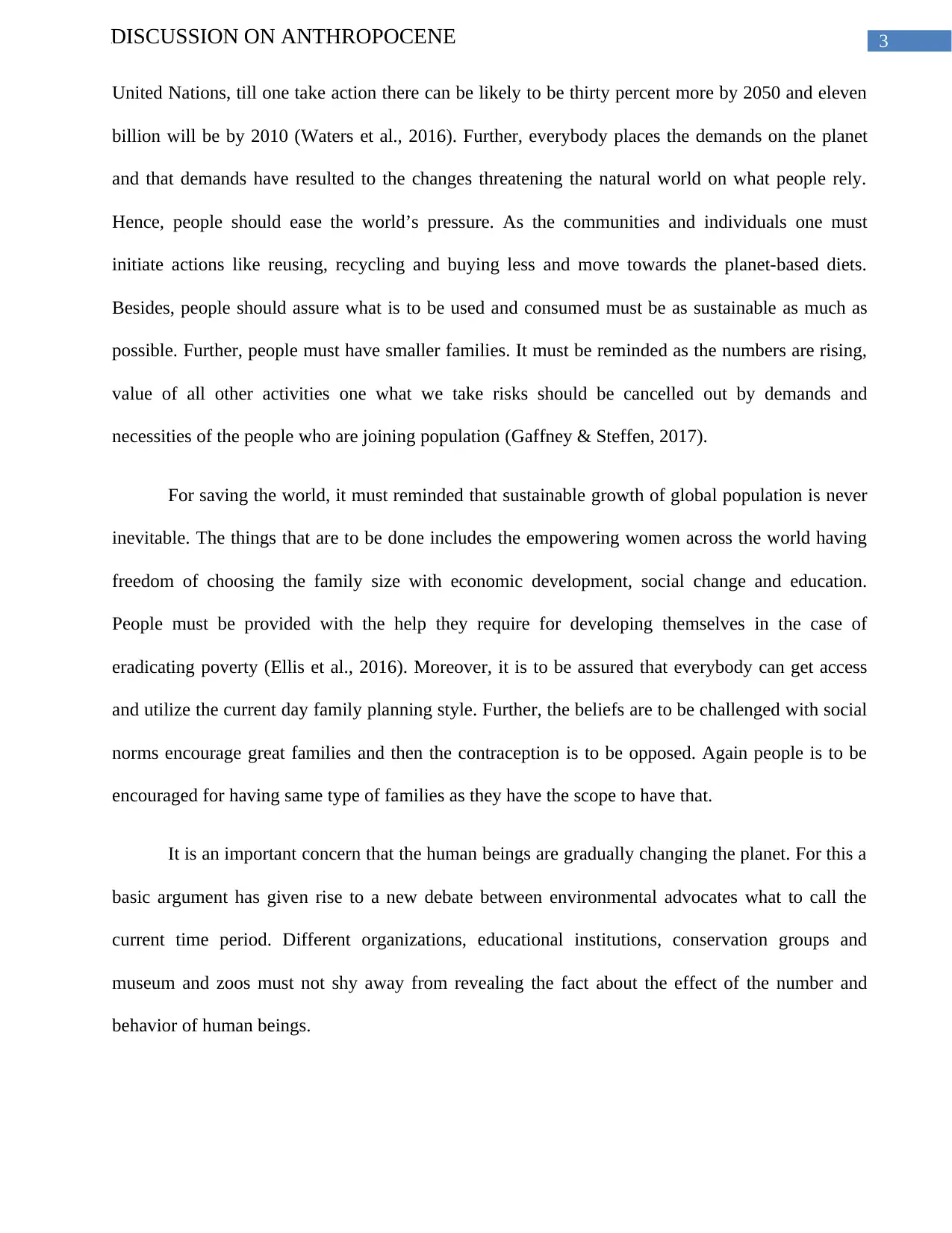
3DISCUSSION ON ANTHROPOCENE
United Nations, till one take action there can be likely to be thirty percent more by 2050 and eleven
billion will be by 2010 (Waters et al., 2016). Further, everybody places the demands on the planet
and that demands have resulted to the changes threatening the natural world on what people rely.
Hence, people should ease the world’s pressure. As the communities and individuals one must
initiate actions like reusing, recycling and buying less and move towards the planet-based diets.
Besides, people should assure what is to be used and consumed must be as sustainable as much as
possible. Further, people must have smaller families. It must be reminded as the numbers are rising,
value of all other activities one what we take risks should be cancelled out by demands and
necessities of the people who are joining population (Gaffney & Steffen, 2017).
For saving the world, it must reminded that sustainable growth of global population is never
inevitable. The things that are to be done includes the empowering women across the world having
freedom of choosing the family size with economic development, social change and education.
People must be provided with the help they require for developing themselves in the case of
eradicating poverty (Ellis et al., 2016). Moreover, it is to be assured that everybody can get access
and utilize the current day family planning style. Further, the beliefs are to be challenged with social
norms encourage great families and then the contraception is to be opposed. Again people is to be
encouraged for having same type of families as they have the scope to have that.
It is an important concern that the human beings are gradually changing the planet. For this a
basic argument has given rise to a new debate between environmental advocates what to call the
current time period. Different organizations, educational institutions, conservation groups and
museum and zoos must not shy away from revealing the fact about the effect of the number and
behavior of human beings.
United Nations, till one take action there can be likely to be thirty percent more by 2050 and eleven
billion will be by 2010 (Waters et al., 2016). Further, everybody places the demands on the planet
and that demands have resulted to the changes threatening the natural world on what people rely.
Hence, people should ease the world’s pressure. As the communities and individuals one must
initiate actions like reusing, recycling and buying less and move towards the planet-based diets.
Besides, people should assure what is to be used and consumed must be as sustainable as much as
possible. Further, people must have smaller families. It must be reminded as the numbers are rising,
value of all other activities one what we take risks should be cancelled out by demands and
necessities of the people who are joining population (Gaffney & Steffen, 2017).
For saving the world, it must reminded that sustainable growth of global population is never
inevitable. The things that are to be done includes the empowering women across the world having
freedom of choosing the family size with economic development, social change and education.
People must be provided with the help they require for developing themselves in the case of
eradicating poverty (Ellis et al., 2016). Moreover, it is to be assured that everybody can get access
and utilize the current day family planning style. Further, the beliefs are to be challenged with social
norms encourage great families and then the contraception is to be opposed. Again people is to be
encouraged for having same type of families as they have the scope to have that.
It is an important concern that the human beings are gradually changing the planet. For this a
basic argument has given rise to a new debate between environmental advocates what to call the
current time period. Different organizations, educational institutions, conservation groups and
museum and zoos must not shy away from revealing the fact about the effect of the number and
behavior of human beings.
Paraphrase This Document
Need a fresh take? Get an instant paraphrase of this document with our AI Paraphraser
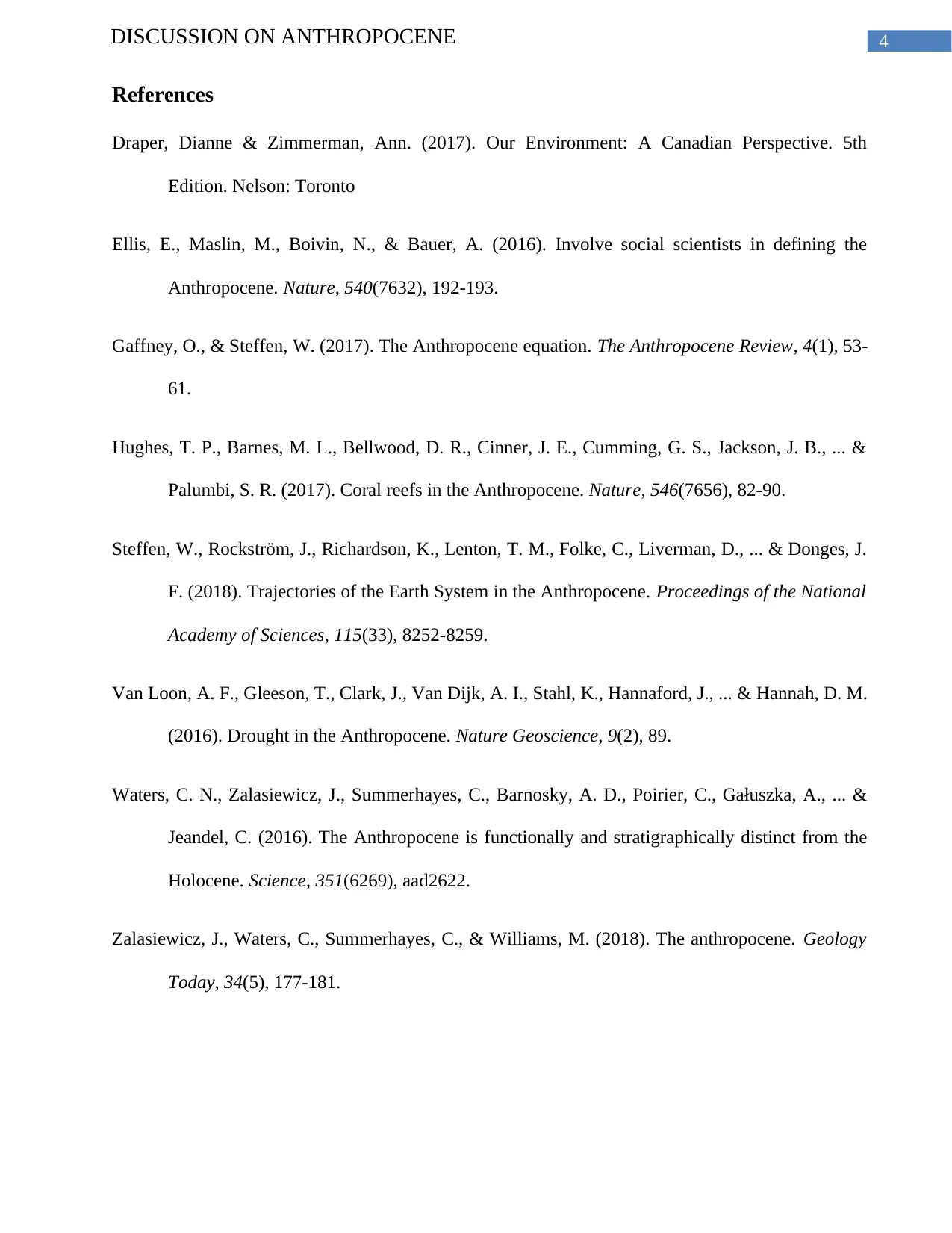
4DISCUSSION ON ANTHROPOCENE
References
Draper, Dianne & Zimmerman, Ann. (2017). Our Environment: A Canadian Perspective. 5th
Edition. Nelson: Toronto
Ellis, E., Maslin, M., Boivin, N., & Bauer, A. (2016). Involve social scientists in defining the
Anthropocene. Nature, 540(7632), 192-193.
Gaffney, O., & Steffen, W. (2017). The Anthropocene equation. The Anthropocene Review, 4(1), 53-
61.
Hughes, T. P., Barnes, M. L., Bellwood, D. R., Cinner, J. E., Cumming, G. S., Jackson, J. B., ... &
Palumbi, S. R. (2017). Coral reefs in the Anthropocene. Nature, 546(7656), 82-90.
Steffen, W., Rockström, J., Richardson, K., Lenton, T. M., Folke, C., Liverman, D., ... & Donges, J.
F. (2018). Trajectories of the Earth System in the Anthropocene. Proceedings of the National
Academy of Sciences, 115(33), 8252-8259.
Van Loon, A. F., Gleeson, T., Clark, J., Van Dijk, A. I., Stahl, K., Hannaford, J., ... & Hannah, D. M.
(2016). Drought in the Anthropocene. Nature Geoscience, 9(2), 89.
Waters, C. N., Zalasiewicz, J., Summerhayes, C., Barnosky, A. D., Poirier, C., Gałuszka, A., ... &
Jeandel, C. (2016). The Anthropocene is functionally and stratigraphically distinct from the
Holocene. Science, 351(6269), aad2622.
Zalasiewicz, J., Waters, C., Summerhayes, C., & Williams, M. (2018). The anthropocene. Geology
Today, 34(5), 177-181.
References
Draper, Dianne & Zimmerman, Ann. (2017). Our Environment: A Canadian Perspective. 5th
Edition. Nelson: Toronto
Ellis, E., Maslin, M., Boivin, N., & Bauer, A. (2016). Involve social scientists in defining the
Anthropocene. Nature, 540(7632), 192-193.
Gaffney, O., & Steffen, W. (2017). The Anthropocene equation. The Anthropocene Review, 4(1), 53-
61.
Hughes, T. P., Barnes, M. L., Bellwood, D. R., Cinner, J. E., Cumming, G. S., Jackson, J. B., ... &
Palumbi, S. R. (2017). Coral reefs in the Anthropocene. Nature, 546(7656), 82-90.
Steffen, W., Rockström, J., Richardson, K., Lenton, T. M., Folke, C., Liverman, D., ... & Donges, J.
F. (2018). Trajectories of the Earth System in the Anthropocene. Proceedings of the National
Academy of Sciences, 115(33), 8252-8259.
Van Loon, A. F., Gleeson, T., Clark, J., Van Dijk, A. I., Stahl, K., Hannaford, J., ... & Hannah, D. M.
(2016). Drought in the Anthropocene. Nature Geoscience, 9(2), 89.
Waters, C. N., Zalasiewicz, J., Summerhayes, C., Barnosky, A. D., Poirier, C., Gałuszka, A., ... &
Jeandel, C. (2016). The Anthropocene is functionally and stratigraphically distinct from the
Holocene. Science, 351(6269), aad2622.
Zalasiewicz, J., Waters, C., Summerhayes, C., & Williams, M. (2018). The anthropocene. Geology
Today, 34(5), 177-181.
1 out of 5
Related Documents
Your All-in-One AI-Powered Toolkit for Academic Success.
+13062052269
info@desklib.com
Available 24*7 on WhatsApp / Email
![[object Object]](/_next/static/media/star-bottom.7253800d.svg)
Unlock your academic potential
Copyright © 2020–2025 A2Z Services. All Rights Reserved. Developed and managed by ZUCOL.





